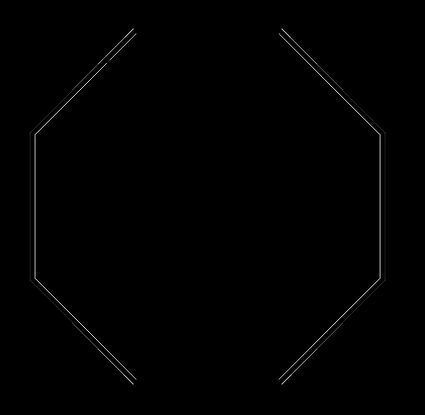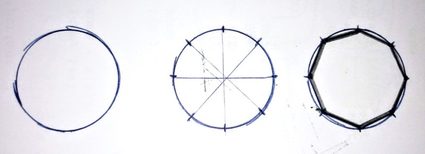Octagon Calculator
Hello and welcome to the octagon calculator, the ultimate tool for everything octangular. Here, we hope you will find an excellent tool for calculating the diagonals, perimeter, circumradius, inradius, and area of a regular octagon. In this octagon area calculator, you will also find the answers to the following questions: what is an octagon, how many sides does an octagon have, how to find the area of a regular octagon or how to draw an octagon.
We will review the octagon definition, discuss the octagon angles and how they affect the octagon shape. On top of all that, we will see a few examples of real-world octagons including octagon tiles, flooring, and the famous "Octagon house".
Octagon definition: How many sides does an octagon have?
The standard definition of an octagon is something along the lines of, "An octagon is a polygon with 8 sides delimiting a closed area." Anyone with a basic understanding of Greek should be able to comfortably answer the question how many sides does an octagon have without any notions of mathematics. That is because "Octo-" in Greek means eight, so it is safe to assume an octagon has eight sides or that an octopus has eight legs.

We will dive a bit deeper into the Greek origin of the octagon shape when we talk about octagon angles, but, for now, let's stick to octagon sides. If someone asks, "how many sides does an octagon have?" the answer is always the same, but if they ask about the length of those sides, we cannot give one answer. Every side of an octagon can have different lengths and still be an octagon; there are no restrictions on that front. However, when all of an octagon's internal angles and side lengths are the same, it is called a regular octagon and has special properties, as we will see in the following sections.
Octagon angles: What is an octagon?
If we look at the origin of the word "Octagon" it comes from the Greek meaning "eight angles". The result of this is a polygon composed of eight vertices joined by eight straight lines. The eight sides are a necessary consequence of having eight angles. In fact, the standard octagon definition defines the octagon as having eight sides rather than eight angles, but you already know that both definitions are virtually the same. So the question what is an octagon? is equally well answered by saying "an eight-sided polygon" as well as "a polygon with eight angles".

While the sides of an octagon can have almost any length, the octagon angles are restricted. There is not a restriction imposed on each angle but on the sum of them. This restriction is geometric since it would be impossible to join all eight sides together without following this rule. For any octagons, the sum of all of its internal angles is always 1080°.
That means that a regular octagon will have internal octagon angles of exactly 1080°/8 = 135° (if you prefer other units, feel free to use our angle converter). In our opinion, a regular octagon is much prettier than all other octagons. Later on in the text, we'll see how to find the area of an octagon and the tricks associated with a regular octagon.
Area of an octagon: How to find the area of a regular octagon?
If you want to know how to find the area of a regular octagon by hand, the easiest procedure is to apply the standard formula for the area of a regular polygon. The formula is the following:
area of regular polygon = perimeter * apothem / 2,
where the apothem is the distance from the center of the polygon to the mid-point of a side.
💡 We can calculate the perimeter a few ways: by summing up the length of each side, multiplying the length of one side by the number of sides, or, if you're feeling lazy, you can also use our perimeter of a polygon calculator.

A trick to remembering this formula is to understand where it comes from. If you look at the apothem, you can see that it's the height of a triangle made by taking a line from the vertices of the polygon/octagon to the center of it. The resulting triangle is what is called an isosceles triangle, and its area is:
area of triangle = base * height / 2
as we explained in the triangle area calculator. Note that the base of the triangle is the length of a side of the octagon. Since there are as many of these triangles as the polygon has sides (eight for an octagon), you have to multiply the area of this triangle by the number of sides. You will obtain the total area of the octagon:
area of octagon = 8 * base * height / 2 = perimeter * apothem / 2.
These tricks work for any polygon, e.g., hexagons and any other polygon you can think of, as long as it is regular. Apart from using triangles, there are other tricks you can use to calculate the area of an octagon if you don't remember the formula, but they will not work for other polygons. For example, if you imagine an octagon shape inside a square, you can see that the difference is only four right triangles. "How to find the area of a regular octagon with this information?", you might ask. Well, it is very easy:
- Calculate the area of the square (the side is
2 * apothem), - Calculate the sides of the right triangles by using the special right triangles calculator.
- Subtract the area of a right triangle four times from the area of the square.
- Enjoy success!

Alternatively, you can use this trick. If you organize the right triangles correctly, you can construct a square from all four of them. In this case, the hypotenuse is also the side of the octagon. Then you can calculate the area of the parallelogram you just made from the four right triangles and subtract it from the area of the big square.
On top of these, you can get even more creative. For example, imagine that the octagon is composed of a rectangle with two trapezoids, with one above and below the rectangle. In this case, it will be much easier to calculate the area since you only have to sum up the area of the rectangle plus double the area of one of the trapezoids, since both trapezoids are equal.
Diagonals of a regular octagon
In total, an octagon has 20 diagonals; the longest ones are on its axes of symmetry, and they meet at the central point, O, which is also the origin of symmetry. There are three types of diagonals (take a look at the image above in the "Area of an octagon" section for reference):
- Short diagonals, for example, AG, FH, or CE;
- Medium diagonals, such as AF or BE (also called the height of an octagon); and
- Long diagonals, for example, AE or BF.
You can derive the formula for each of them with ease using the basic principles of geometry. Here are the formulas for the length of the diagonals:
- Short diagonal
s = a * √(2 + √2) - Medium diagonal
m = a * (1 + √2) - Long diagonal
l = a * √(4 + 2√2)
If you're feeling lazy or find yourself in a rush, just use the octagon calculator.
Circumradius and inradius
We should also talk about the circumradius and the inradius. Our octagon area calculator is capable of finding the radii of the circumscribed and inscribed circles.
You can notice that the circumradius is simply half of the length of the longest diagonal:
R = l/2 = a / 2 * √(4 + 2√2)
Similarly, the inradius is the same as the apothem, which is just half of the octagon's height:
r = m/2 = a/2 * (1 + √2)
Octagon shape: How to draw an octagon?
It might seem easy to draw an octagon at first, and, in principle, it is. Just draw any shape with eight straight sides, and you're done. But typically, what people want to draw is not any octagon, but a regular octagon, as it's the octagon shape that comes to mind first. So let's see how to draw an octagon as regularly and as easily as possible.
The most precise way would be to use proper drawing tools and start drawing the regular octagon shape one side at a time, joining them with the corresponding 135° regular octagon angles. But not everyone has such tools laying around, so it is not a very practical method. To obtain the octagon shape we are looking for, it is best to start with its circumference since it can be drawn by hand (not recommended) or by using a glass, cup, or even a coin.

With the circumference drawn, start dividing the corresponding circle area into halves. First, you will make two half-circles. Then, split them in half again and get four quarter circles. Halve it once more, and you end up with eight circle-eights. We can now take the points of division along the circumference and join the adjacent ones with a straight line. The result is a perfectly regular octagon, minus the human error you may make while drawing and halving.
Another how-to-draw an octagon trick would be the one we have already discussed when learning how to find the area of an octagon with squares. Start by drawing a big square and then 'chop off' its corners. The mathematical term for this procedure is truncating the square. If you do it right, you will get a regular octagon shape out of it. This method is not as precise as the previous one, but it's easier to perform without any tools at all.
How to use the octagon calculator
Using the octagon calculator isn't too complicated, but just in case someone might have any doubts and for the sake of completeness, let's go over the features and uses of this octagon area calculator. First of all, we should look at the different fields and what they mean.
Side Length- It is the length of each side of the regular octagon;Perimeter- Sum of the length of all the sides of the octagon;Area- Space enclosed by the octagon itself;Longest diagonal- Length of the line joining 2 furthest vertices;Medium diagonal- Length of the line joining 2 vertices with 2 vertices between them;Shortest diagonal- Length of the line joining 2 vertices with 1 vertex in between them;Circumcircle radius- Radius of the circumference that contains all 8 vertices of the regular octagon; andIncircle radius- Radius of the smallest circumference that is tangent to all 8 sides.
Now that you know what each parameter means, it is time to see how to use the octagon calculator to obtain the values you are looking for easily. The best feature of this calculator is that it only requires one input to calculate the rest of the values. This innovation makes the octagon calculator the fastest way to calculate any properties of an octagon by a significant margin.
Octagons in real life: the octagon house
So far, we have talked about the octagon definition and how to draw an octagon. We've seen pictures of octagons and even answered the (now obvious) question of how many sides does an octagon have. Now, it is time to see how octagons are used in real life. The octagon shape is easier to manufacture and use in designs than a circle due to the flat sides and the octagon angles. We can often find octagon tiles as flooring or in a bathroom. There are even houses that have an octagon shape, most notably the famous "Octagon House".

The Octagon House was built in an octagonal shape in Washington D.C., USA for Colonel John Tayloe III. For this reason, it's also known as the Colonel John Tayloe III House. It follows the American "tradition" of naming buildings after their shape, as they did with the Pentagon. The Pentagon is the United States Department of Defence headquarters and was built in the shape of a regular pentagon.
The Octagon house has many interesting architectural features, such as a triangular service stairway, a bigger oval stairway, and the obvious octagonal shape of the building. On top of such unique characteristics, several ghost stories surround the house, partly because the owner was an important figure in early American history.
More real-world uses of Octagons: Octagon tiles and camera apertures
Like any regular polygon, the octagon shape turns out to be useful in many different applications. We have already talked about making houses in an octagonal shape, and, sticking with buildings, octagons are particularly popular when it comes to flooring, mainly in the form of octagon tiles. The shape of a regular octagon means that we can combine octagon tiles and square tiles to fill any room's floor completely, no matter its square footage.
Using a different pattern in each type of tile or using different colors, these combinations would allow you to create a beautiful floor for your kitchen or bathroom.
Another exciting use of octagons is inside photographic cameras. In particular, the shutter protects the sensor from exposure to light when the camera is not in use. This shutter, or aperture, is always made following a regular polygonal shape, including the octagon shape. You can learn more about aperture and how to play with it to get more professional-looking pictures with our aperture area calculator.
Before you head out to check that calculator, we want to give you a quick tip/trick. When you see a picture of a bright source of light, you might have noticed that it looks like a star with a different number of pointy arms, depending on the camera. This observation is the key to figuring out if your camera has an octagon aperture or not: the number of pointy arms is precisely equal to the number of sides of the polygon that makes up the aperture. And how many sides does an octagon have? Exactly! So you only need to look for 'star shapes' with 8 pointy arms, and you'll know that this picture was taken using an octagonal aperture. It works every time - it's physics, and, more specifically, a diffraction pattern.
FAQs
What are the concave and convex octagons?
A convex octagon has all of its interior angles less than 180°. A concave octagon has at least one interior angle greater than 180°. A regular octagon is a convex octagon, as all of its angles are 135°.
What is the sum of the angles of an octagon?
The sum of the angles of an octagon is 1080°. The sum of the interior angles of a polygon with n number of sides is always (n − 2) × 180°. Thus, an octagon's angles add up to (8 − 2) × 180° = 1080°.
How do I calculate the area of an octagon of side 5 cm?
The formula estimating a regular octagon's area is A = 2 × (1+√2) × a2, where a is the side length. Thus, your octagon with a side length of 5 cm has an area of 2 × (1+√2) × 52 = 120.71 cm2.
What is the maximum side length of a regular octagon made using letter-sized paper?
The formula for calculating side length, a, using the diameter, d, is a = d × sin α, where α is the isosceles triangles' apex angle.
The dimension of a standard letter in the US is 8.5 × 11 inches. So, we can cut a square of maximum length 8.5 × 8.5 inches. Hence, the octagon's maximum diameter, d, is 8.5 in. Thus, the side length = 8.5 in × sin 45° = 6 in.
